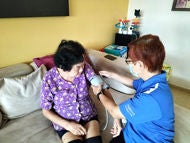What is - Sarcoma

- Gastrointestinal stromal tumours (GISTs) – usually forms in the digestive tract, tend to be large and can spread to other parts of the body.
- Liposarcoma – originates in fatty tissue with some types being more aggressive than others.
- Leiomyosarcoma – forms in the smooth muscle tissue that lines hollow organs. In women, the uterus is the most common location for this type of sarcoma.
- Undifferentiated pleomorphic sarcoma (UPS) – can form anywhere, usually occurs in the abdomen, on arms and legs (especially thighs), and grows and spreads quickly to other parts of the body.
- Synovial sarcoma – more common in children and young adults. Usually occurs on the arms, legs, finger and toes.
Some types of bone sarcoma are:
- Osteosarcoma – also called osteogenic sarcoma, these begin in cells within the bones and often occur in the arms and legs.
- Chondrosarcoma – starts in the cartilage, often found in the pelvis, upper leg and shoulder bones.
- Ewing sarcoma – can occur in any bone and can also occur in soft tissue, most commonly affects the pelvis, thigh, lower leg, upper arm and chest wall.
- Chordoma – a rare form of bone sarcoma that can occur in the skull or spine.
- Giant cell tumours – a rare form of bone sarcoma that can grow quickly and become cancerous, often forms near the joints.
Symptoms of Sarcoma
The most common symptoms that patients present with include:
- Lumps / Growths in any part of the body, including limbs that are persistent and progressing, usually painless
- Pain or symptoms due to the local effects of the mass
When should you see a doctor?
- Noticeable lumps, masses or growths, even if they are painless
- Masses or growths that increase in size over time
Sarcoma - How to prevent
It is not clear what causes most sarcomas, so little is known on how to prevent them. However, doctors recommend avoiding the known risk factors (see section on ‘Causes and Risk Factors’).
Sarcoma - Causes and Risk Factors
There are very few known risk factors for sarcomas and patients do not always present with them. However, some causes and risk factors may include:
- Family history of cancer-related syndromes such as neurofibromatosis. Neurofibromatosis can cause multiple benign enlargements of nerve sheaths, leading to a higher risk of one of these enlarged nerve sheaths turning cancerous. Other syndromes that may increase risk are Li-Fraumeni syndrome, familial adenomatous polyposis, Carney-Stratakis syndrome, hereditary retinoblastoma, neurofibromatosis and BRCA2 gene mutations.
- Past radiotherapy treatment can lead to a slightly higher chance of developing a sarcoma within the previously radiated area. This can occur years later.
- Exposure to certain toxic chemicals such as industrial chemicals or herbicides.
- A damaged lymphatic system, the network of tissues, vessels and organs that are an important part of the immune system.
Diagnosis of Sarcoma
Sarcoma patients usually consult a doctor after noticing a lump or mass on the abdomen, trunk, arms of legs. The lump may or may not be painful. There are several tests that can be used to diagnose sarcoma and determine whether it has spread.
Tests and procedures used to diagnose sarcoma:
- MRI/CT scans Imaging of the affected area is performed to assess the local extent of the disease and to help guide biopsy or surgical planning. A full-body evaluation using a CT scan or PET-CT is also conducted to determine the overall extent of the disease and to check for any spread (metastasis).
- Biopsy
- A sample is taken by removing a piece of tissue from the lump/mass for examination and testing in the laboratory. This determines the diagnosis and the subtype of the sarcoma.
- It is important that any suspicious lump is thoroughly evaluated before a biopsy is performed. Individuals with a suspicious lump should be referred to a sarcoma specialist for a comprehensive assessment prior to undergoing a biopsy. Evidence shows that a well-planned, pre-operative evaluation and biopsy by a sarcoma specialist can significantly improve patient outcomes. In contrast, poorly planned biopsies can lead to local contamination, inadequate surgical clearance and ultimately poorer outcomes.
- At NCCS, the SPRInT team offers a fast-track referral service for General Practitioners (GPs) to refer patients with suspicious lumps for prompt evaluation. This service, known as the NCCS SPEED Initiative (Sarcoma Pre-emptive Evaluation and Diagnosis), aims to facilitate early diagnosis and timely management of suspicious lumps and ultimately improve outcomes for patients.
What are the stages of sarcoma?
Most sarcomas are classified using the TNM system:
- T (Tumour): Indicates the size and location of the primary tumour.
- N (Nodes): Shows if the cancer has spread to surrounding lymph nodes.
- M (Metastasis): Indicates if the cancer has spread to other organs.
Treatment for Sarcoma
An individual with sarcoma should be assessed by a multi-disciplinary team of specialists to determine which modalities of treatment are best suited for them. All sarcoma cases seen at SingHealth institutions are reviewed at a weekly multidisciplinary tumour board, where decisions on treatment are made following discussions, so that care is holistically managed.
- Surgery
Surgical resection with appropriate negative margin is the primary treatment for most subtypes of localised sarcoma. Some patients may require systemic treatment or radiotherapy to be delivered prior to the surgery to either downsize the tumour or to minimise risk of systemic relapse.
- Radiotherapy
Radiation or radiotherapy uses high-energy X-rays to kill cancer cells. The aim of radiotherapy is to destroy cancer cells and spare as many normal cells as possible. For sarcoma patients, radiotherapy to the arms and legs is associated with redness of the skin and hair loss over the radiated area. Radiotherapy to the head and neck region may cause sides effects such as temporary redness of the skin, loss of appetite, loss of salivation and dryness of the mouth. Radiotherapy to the stomach region may cause temporary nausea and vomiting, loss of appetite, and occasional gastric pain. Your doctor will discuss with you how to manage these side effects.
- Systemic therapy
Systemic therapy refers to use of drugs to treat cancer. This includes chemotherapy, targeted therapy or immunotherapy.
Chemotherapy is the use of anti-cancer drugs to destroy cancer cells. Chemotherapy is administered into the veins in the hand and can cause various side effects including low blood counts, infections and side effects specific to certain drugs.
Targeted drugs are used in certain specific sarcomas. These drugs target specific pathways or molecules that are involved in cancer growth and spread. Immunotherapy is a type of treatment that harnesses the immune system to fight cancer. This is only suitable for use in specific subtypes in sarcoma.
Pre-Surgery Preparation for Sarcoma
Before surgery, your surgeon will perform comprehensive medical assessments including blood tests and scans to see if you are suitable for surgery and advise on the risks involved. Your treatment recommendation is often based on consensus by a multi-disciplinary team known as the tumour board, who come together to discuss the pros and cons of every treatment strategy recommended.
Before surgery, the anaesthesia team will assess your fitness for surgery and advise you on various aspects of general anaesthesia and pain control after surgery.
Specialist nurses will provide pre-surgery counselling.
Post-Surgery Care for Sarcoma
After surgery, you will be given regular outpatient appointments to see your team of doctors. During these appointments you may have blood tests and scans to check if the cancer recurs.
It is important to follow your doctor's advice, keep to your clinic visits and do the recommended scans and tests, so that timely treatment can be administered if the cancer recurs or other problems occur.
Sarcoma - Other Information
- Can sarcoma spread to other parts of the body?
Yes, sarcoma can spread to other areas, most commonly, the lungs. The likelihood of spread depends on the type, size and stage of the tumour at diagnosis.
- Is sarcoma hereditary?
Most sarcomas occur sporadically, but some types can be linked to inherited genetic conditions, such as Li-Fraumeni syndrome or neurofibromatosis. A family history will be obtained during the consult to determine the need for referral to the cancer genetics team for further evaluation.
- What is the survival rate for sarcoma?
Survival rates vary depending on the type, location and stage at diagnosis. Early-stage sarcomas have a better prognosis, while advanced cases with metastasis are more challenging to treat.
References
R;, P. E. (n.d.). Soft tissue sarcoma in Asia. Chinese clinical oncology. https://pubmed.ncbi.nlm.nih.gov/30173536/
Soft tissue sarcoma: Soft tissue sarcoma information. Soft Tissue Sarcoma Information | American Cancer Society. (n.d.). https://www.cancer.org/cancer/types/soft-tissue-sarcoma.html
National Cancer Institute. (n.d.). Soft tissue sarcoma—Patient version. National Institutes of Health. https://www.cancer.gov/types/soft-tissue-sarcoma
Webinars:
- 8th Singapore Sarcoma Symposium
Presentation:
|
Contributed by
The information provided is not intended as medical advice. Terms of use. Information provided by SingHealth.
Condition Treated At
Department
Oncologic Imaging
Department
Medical Oncology
Department
Radiation Oncology
Department
Surgery and Surgical Oncology, SGH & NCCS
Department
Surgery
Get to know our doctors at SingHealth Hospitals in Singapore.
Get to know our doctors at SingHealth Hospitals in Singapore. here.




















